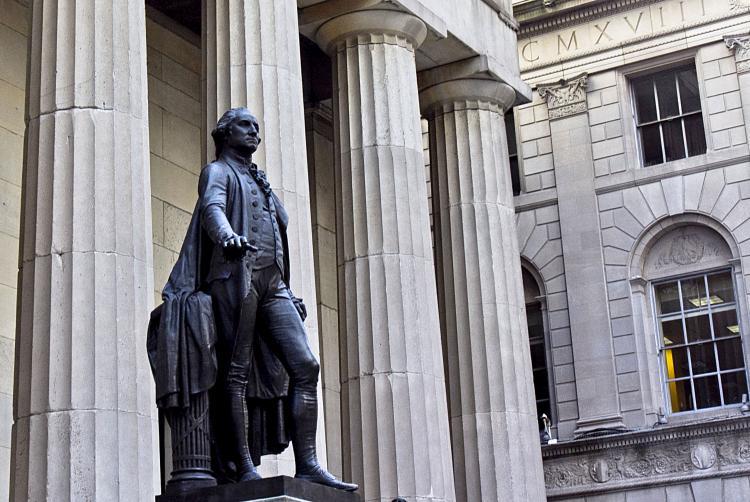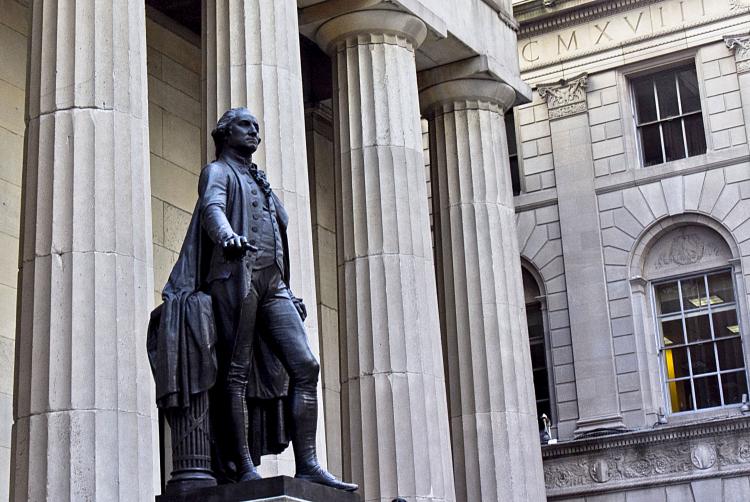NEW YORK—Celebrating Presidents Day in New York City is only natural: Our nation’s first president, whose birthday falls on Tuesday, Feb. 22, was inaugurated in Lower Manhattan and spent his first year in office in the city, before moving to Philadelphia and then on to the new capital in Washington, D.C.
When America won its independence, Washington, D.C., was but a marshland along the Potomac River, and New York was truly the bustling center and the capital of the new nation. New York City was a British and loyalist stronghold for much of the American War of Independence, and at the culmination of that war it became the site of the first American presidential inauguration.
George Washington set out from his home in Mount Vernon, Va., to come to New York on April 16, 1789.
He wrote in his journal: “About 10 o'clock I bade adieu to Mount Vernon, to private life, and to domestic felicity, and with a mind oppressed with more anxious and painful sensations than I have words to express, set out for New York in company with Mr. Thompson and Colonel Humphries, with the best dispositions to render service to my country in obedience to its call, but with less hope of answering its expectations.”
Hence, he returned to New York City. Six years earlier, he had bid farewell to his officers at Fraunces Tavern, which still stands on Pearl Street to this day. After years of hardship, battling what must at times have seemed an impenetrable foe, weathering winters with little food and little hope, the men watched in triumph on Evacuation Day, Nov. 25, 1783, as the defeated British troops left Manhattan.
Washington’s return to the city after he was declared the first president by the Electoral College was an inspiring sight, as Rudolph Von Dorsten, the secretary of Dutch Legation in New York City, described in his journal. The soon-to-be president’s barge was flanked by citizen ships and greeted by the top officials of the time, including Gov. George Clinton.
“A Spanish royal packet-boat, happening to be anchored at the entrance of the harbor at sight of the barge, on board of which was the president, fired a signal-shot, whereupon that vessel was dressed at once with the flags of all nations. When the presidential barge passed, the Spanish vessel saluted His Excellency by firing 13 guns, which was repeated by the Battery, and again 13 guns were fired by the fort when the president landed,” wrote Von Dorsten, bringing the scene to life in detail.
Washington did not seek the office. His ascendance to the presidency was a far cry from the prolonged and expensive campaigns of today. The nation’s first president was, in fact, somewhat reluctant to take the seat, but “accepted the inevitability of his election as president,” as a University of Virginia account put it.
Steadfast in battle, and unwavering in front of his Patriot troops, the general was nonetheless nervous at his inauguration ceremony, according to the first-hand accounts of Rep. Fisher Ames and Sen. William Maclay. The ceremony was held at the Federal Hall on Wall Street.
“It was a very touching scene,” Ames wrote, “and quite of the solemn kind. His [Washington’s] aspect grave, almost to sadness; his modesty actually shaking; his voice deep, a little tremulous, and so low as to call for close attention.”
Maclay saw the president in a more critical light.
“He trembled, and several times could scarce make out to read, though it must be supposed he had often read it before,” described Maclay. “When he came to the words ‘all the world,’ he made a flourish with his right hand, which left rather an ungainly impression.”
Wishing the president had delivered his inaugural address more plainly, Maclay lamented, “I felt hurt that he was not first in everything.”
Whatever the impression left by Washington’s demeanor—as he stood with a sword in a dark-brown jacket, with eagles emblazoned on the metal buttons, and white stockings—the enthusiasm with which New Yorkers greeted their first president could not be contested.
Washington was met with “repeated shouts and huzzas, ‘God bless our Washington! Long live our beloved president!’” wrote Tobias Lear, Washington’s personal secretary.
The president watched the display as the fireworks erupted from Bowling Green that inaugural night. He then retired to his home on Cherry Street by the East River, where he would remain until the capital moved south about a year later.
Sources:
Papers of George Washington from the University of Virginia
Swamps and the City of Washington thread from H-URBAN, an online moderated, multi-disciplinary forum for discussion and dissemination of scholarship on urban history and urban studies.
“The Encyclopedia of New York City,” edited by Professor Kenneth T. Jackson.
EyeWitness to History
When America won its independence, Washington, D.C., was but a marshland along the Potomac River, and New York was truly the bustling center and the capital of the new nation. New York City was a British and loyalist stronghold for much of the American War of Independence, and at the culmination of that war it became the site of the first American presidential inauguration.
George Washington set out from his home in Mount Vernon, Va., to come to New York on April 16, 1789.
He wrote in his journal: “About 10 o'clock I bade adieu to Mount Vernon, to private life, and to domestic felicity, and with a mind oppressed with more anxious and painful sensations than I have words to express, set out for New York in company with Mr. Thompson and Colonel Humphries, with the best dispositions to render service to my country in obedience to its call, but with less hope of answering its expectations.”
Hence, he returned to New York City. Six years earlier, he had bid farewell to his officers at Fraunces Tavern, which still stands on Pearl Street to this day. After years of hardship, battling what must at times have seemed an impenetrable foe, weathering winters with little food and little hope, the men watched in triumph on Evacuation Day, Nov. 25, 1783, as the defeated British troops left Manhattan.
Washington’s return to the city after he was declared the first president by the Electoral College was an inspiring sight, as Rudolph Von Dorsten, the secretary of Dutch Legation in New York City, described in his journal. The soon-to-be president’s barge was flanked by citizen ships and greeted by the top officials of the time, including Gov. George Clinton.
“A Spanish royal packet-boat, happening to be anchored at the entrance of the harbor at sight of the barge, on board of which was the president, fired a signal-shot, whereupon that vessel was dressed at once with the flags of all nations. When the presidential barge passed, the Spanish vessel saluted His Excellency by firing 13 guns, which was repeated by the Battery, and again 13 guns were fired by the fort when the president landed,” wrote Von Dorsten, bringing the scene to life in detail.
Washington did not seek the office. His ascendance to the presidency was a far cry from the prolonged and expensive campaigns of today. The nation’s first president was, in fact, somewhat reluctant to take the seat, but “accepted the inevitability of his election as president,” as a University of Virginia account put it.
Steadfast in battle, and unwavering in front of his Patriot troops, the general was nonetheless nervous at his inauguration ceremony, according to the first-hand accounts of Rep. Fisher Ames and Sen. William Maclay. The ceremony was held at the Federal Hall on Wall Street.
“It was a very touching scene,” Ames wrote, “and quite of the solemn kind. His [Washington’s] aspect grave, almost to sadness; his modesty actually shaking; his voice deep, a little tremulous, and so low as to call for close attention.”
Maclay saw the president in a more critical light.
“He trembled, and several times could scarce make out to read, though it must be supposed he had often read it before,” described Maclay. “When he came to the words ‘all the world,’ he made a flourish with his right hand, which left rather an ungainly impression.”
Wishing the president had delivered his inaugural address more plainly, Maclay lamented, “I felt hurt that he was not first in everything.”
Whatever the impression left by Washington’s demeanor—as he stood with a sword in a dark-brown jacket, with eagles emblazoned on the metal buttons, and white stockings—the enthusiasm with which New Yorkers greeted their first president could not be contested.
Washington was met with “repeated shouts and huzzas, ‘God bless our Washington! Long live our beloved president!’” wrote Tobias Lear, Washington’s personal secretary.
The president watched the display as the fireworks erupted from Bowling Green that inaugural night. He then retired to his home on Cherry Street by the East River, where he would remain until the capital moved south about a year later.
Sources:
Papers of George Washington from the University of Virginia
Swamps and the City of Washington thread from H-URBAN, an online moderated, multi-disciplinary forum for discussion and dissemination of scholarship on urban history and urban studies.
“The Encyclopedia of New York City,” edited by Professor Kenneth T. Jackson.
EyeWitness to History







